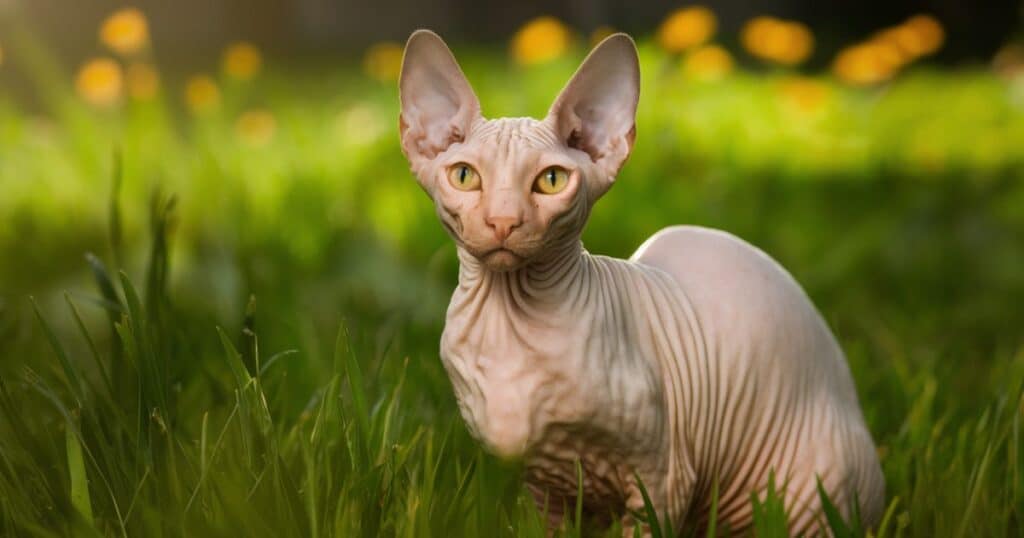Cat allergies are a common struggle for many pet lovers, affecting up to 20% of the population. The appeal of hypoallergenic breeds like the Sphynx cat is undeniable for those seeking feline companionship without the sneezing, wheezing, and itchy eyes that often accompany allergic reactions.
However, the question remains: are Sphynx cats truly hypoallergenic? In this comprehensive guide, we’ll explore the facts about this hairless breed, allergy triggers, and tips for managing allergy symptoms around cats.
What Is a Sphynx Cat?

The Sphynx is a unique and striking breed known for its hairless appearance and warm, velvety skin. Originating in Toronto, Canada in the 1960s, these furless cats are the result of a natural genetic mutation. Despite their unconventional looks, Sphynx cats are highly affectionate, intelligent, and energetic companions, often described as having a dog-like loyalty to their owners.
Their lack of fur means Sphynx cats require special care, including regular bathing and moisturizing to keep their skin healthy. Additionally, they are prone to getting cold easily, so owners must provide warm environments and clothing for their Sphynx during cooler months.
Are All Sphynx Cats Hairless?
While Sphynx cats are renowned for their hairless bodies, it’s a common misconception that they are completely furless. In reality, most Sphynx have a light dusting of fine, downy hair on their bodies, known as “chamois.” This residual hair can vary in amount from cat to cat, with some having more prominent hair growth than others.
The presence of this fine shedding fur can still trigger allergic reactions in some allergy sufferers, albeit potentially to a lesser degree than with cats with thicker, fluffy fur coats. However, it’s important to note that the primary allergy trigger is not the fur itself, but rather a shedding protein called Fel d 1, which is present in a cat’s saliva, dander, and skin oils.
MORE POST: How Much Does A Sphynx Cat Cost In 2024?
Skin Care for Sphynx Cats
Skin Issues for Sphynx Cats
Due to their lack of protective fur, Sphynx cats require special skin care to maintain their health and comfort. Common issues include:
- Oily skin and acne: Without fur to absorb excess oils, Sphynx can develop clogged pores and acne-like lesions.
- Sunburn and skin cancer risk: Their exposed skin is vulnerable to UV damage from prolonged sun exposure.
- Dry, flaky skin: Lack of fur means their skin doesn’t retain moisture as well, leading to dryness and irritation.
- Sensitivity to temperatures: Sphynx cats are prone to getting cold easily and may require sweaters or heating pads in cooler environments.
Regular bathing with gentle, moisturizing shampoos, application of pet-safe sunscreen, and the use of humidifiers can help mitigate these issues and keep a Sphynx’s skin healthy.
What Causes an Allergy to Cats?
Cat allergies are triggered by an overreaction of the immune system to certain proteins found in a cat’s saliva, dander (dead skin cells), and urine. The primary culprit is a protein called Fel d 1, which is produced in a cat’s saliva and sebaceous glands and spreads when the cat licks and grooms itself.
When these allergens become airborne and are inhaled or come into contact with the eyes, nose, or mouth of an allergy sufferer, the body’s immune system mistakenly identifies them as harmful invaders and releases histamines and other chemicals to fight them off. This reaction manifests as the familiar allergy symptoms like sneezing, itchy eyes, runny nose, and respiratory issues.
Interestingly, the amount of Fel d 1 produced by a cat can vary based on factors like breed, age, sex, and even individual biochemistry, which may contribute to different levels of allergy triggers among different cats.
What Triggers Pet Allergies in Sufferers?
While the root cause of cat allergies lies in the immune system’s response to feline proteins like Fel d 1, there are two main ways these allergens can trigger reactions in allergy sufferers:
- Inhalation: When airborne allergens from a cat’s dander, saliva, or urine are breathed in, they can irritate the eyes, nose, and respiratory system.
- Direct contact: Petting, cuddling, or being licked by a cat can transfer allergens from their fur, skin, or saliva directly onto the skin or into the eyes and nose, causing localized reactions.
It’s important to note that allergy symptoms can persist even when a cat is not present, as dander and other allergens can linger in fabrics, carpets, and furniture for months after a cat has been in the area.
Why Sphynx Cats Aren’t Truly Hypoallergenic
While the Sphynx breed’s lack of a thick fur coat may reduce the amount of airborne dander and shed hair, they still produce the Fel d 1 protein that is the primary allergy trigger for cat allergies. This protein is present in their saliva, skin oils, and sebaceous glands, which means even hairless cats like the Sphynx can cause allergic reactions in sensitive individuals.
Additionally, as mentioned earlier, most Sphynx cats have a light dusting of hair, which can still shed and contribute to allergen levels, albeit potentially to a lesser degree than heavily shedding breeds.
In short, while Sphynx cats may be more allergy-friendly than their furry counterparts, they cannot be considered truly hypoallergenic. However, for some allergy sufferers, their reduced allergen levels may make them a more manageable option.
Allergies & Sphynx Cats
Anecdotal evidence and expert opinions vary regarding the impact of Sphynx cats on allergy sufferers. Some individuals report significantly reduced allergy symptoms around Sphynx cats, while others experience little to no difference compared to other breeds.
A study published in the Journal of Allergy and Clinical Immunology found that while Sphynx cats produced lower levels of the Fel d 1 protein compared to furry breeds, they still triggered allergic reactions in some participants.
Ultimately, the severity of an individual’s allergic reaction to a Sphynx cat will depend on various factors, including the cat’s specific allergen levels, the person’s sensitivity, and the extent of exposure.
Are There Hypoallergenic Cats?
There Is No Such Thing as a Hypoallergenic Cat. While certain breeds of cats may produce lower levels of allergens, there is no such thing as a 100% hypoallergenic cat breed. All cats produce the Fel d 1 protein and other allergens that can trigger reactions in sensitive individuals.
However, some breeds are considered more allergy-friendly or hypoallergenic than others due to their reduced allergen production or other characteristics that may minimize allergy symptoms.
What Makes a Cat Hypoallergenic?
Several factors can contribute to making a cat breed more hypoallergenic or allergy-friendly:
- Reduced shedding: Cats that shed less fur and dander may produce fewer airborne allergens.
- Lower Fel d 1 levels: Some breeds naturally produce lower levels of the Fel d 1 protein, the primary allergy trigger.
- Lack of hair: Hairless cats like the Sphynx may have less dander and shed hair, reducing allergen levels.
- Frequent grooming: Regular bathing and brushing can help remove loose hair and dander, reducing allergen buildup.
It’s important to note that while these factors may make certain breeds more manageable for allergy sufferers, they do not eliminate the risk of allergic reactions
What Kinds of Cats Are Hypoallergenic?
While no cat breed is truly 100% hypoallergenic, some are considered more allergy-friendly due to their lower allergen production. Here are some of the most popular “hypoallergenic” cat breeds:
Siberian Cats
Siberian cats are known for producing lower levels of the Fel d 1 protein, which can make them more tolerable for some allergy sufferers. Their semi-long, triple-layered coats are also less likely to produce excessive dander.
Bengal Cats
The sleek, short coats of Bengal cats shed minimally, reducing the amount of airborne allergens they produce. Additionally, their unique pelt pattern and texture may contribute to lower dander levels.
Russian Blue
With their plush, dense double coats, Russian Blues are said to be more allergy-friendly due to their reduced shedding and dander production compared to other long-haired breeds.
Oriental Shorthair
As their name suggests, Oriental Shorthairs have short, fine coats that produce less fur and dander than many other breeds, potentially making them more suitable for allergy sufferers.
Devon Rex and Cornish Rex
These unique breeds are known for their tightly curled, minimal coats that produce very little shedding or dander, potentially reducing allergen levels.
Balinese Cats
While not entirely hairless, the sleek, long-haired Balinese breed is considered hypoallergenic due to their minimal shedding and grooming that helps remove loose hair and dander.
Burmese Cats
The short, close-lying coats of Burmese cats may make them more allergy-friendly, as they tend to produce less shedding and dander than other breeds.
Sphynx Cats
As we’ve discussed, the hairless Sphynx breed may be more manageable for some allergy sufferers due to their lack of fur and reduced shedding, although they still produce allergens.
Are Any Other Cat Breeds Better for Allergic People?
In addition to the breeds mentioned above, allergy sufferers may also want to consider the following cat breeds, which are often recommended as being more allergy-friendly:
- Javanese
- Siamese
- Colorpoint Shorthair
- LaPerm
- Javanese
- Siberian
It’s important to note that while these breeds may produce lower levels of allergens, individual cats within the same breed can still vary in their allergen production. Additionally, no cat breed is completely hypoallergenic, and allergy sufferers may still experience reactions, even with these “allergy-friendly” breeds.
Factors to Consider When Choosing a Hypoallergenic Cat
If you’re an allergy sufferer considering a cat, there are several factors to keep in mind when choosing a breed:
- Coat length and type: Generally, cats with shorter, tighter coats tend to produce less shedding and dander than those with longer, fluffier coats.
- Grooming requirements: Breeds that require frequent grooming may help reduce allergen buildup by removing loose hair and dander.
- Individual allergen levels: Even within the same breed, individual cats can vary in their allergen production based on factors like age, sex, and overall health.
- Lifestyle compatibility: Consider the breed’s energy levels, temperament, and care requirements to ensure a good fit with your lifestyle.
It’s always a good idea to spend time around a particular cat breed or individual cat before committing to adoption to gauge your potential allergic reaction.
Myths About Hypoallergenic Cats
There are several persistent myths surrounding hypoallergenic cats that are important to debunk:
- Myth: Cats that groom themselves frequently are hypoallergenic. While grooming can help remove loose hair and dander, it does not eliminate the allergens produced by a cat’s saliva and skin oils.
- Myth: Certain coat colors are hypoallergenic. A cat’s fur color has no bearing on its allergen production.
- Myth: Kittens are hypoallergenic. While kittens may produce slightly lower allergen levels initially, their allergen production often increases as they mature.
- Myth: Neutered cats are hypoallergenic. Neutering or spaying a cat does not affect its allergen production.
- Myth: Outdoor cats are hypoallergenic. Whether a cat lives indoors or outdoors has no impact on its allergen levels or potential to trigger allergies.
It’s important to separate fact from fiction when it comes to understanding and managing cat allergies.
Managing Allergies with Hypoallergenic Cats

Even if you choose a breed considered more allergy-friendly, it’s still crucial to take precautions to minimize exposure to allergens and manage your allergy symptoms. Here are some tips:
- Bathe your cat regularly: Weekly or bi-weekly bathing can help remove allergens from your cat’s skin and coat.
- Groom and brush frequently: Brushing and combing your cat regularly can help remove loose hair and dander before it becomes airborne.
- Use HEPA air filters: High-Efficiency Particulate Air (HEPA) filters can help remove airborne allergens from your home.
- Vacuum and clean regularly: Frequent vacuuming and cleaning of surfaces can help reduce allergen buildup in your living environment.
- Create a cat-free zone: Designate at least one room in your home as a cat-free area to have a space free of allergens.
- Consult an allergist: An allergy specialist can help identify the severity of your allergy and recommend appropriate treatments and management strategies.
Remember, even with an allergy-friendly breed, some level of exposure to allergens is inevitable when living with a cat. Consistent management and monitoring of your symptoms are essential for maintaining a comfortable coexistence.
What to Do About an Allergy to Cats
If you’re an allergy sufferer with a desire to own a cat, there are several steps you can take to manage your symptoms and improve your quality of life:
Bath the Cat Regularly
Regular bathing (once a week or bi-weekly) can help remove allergens like dander, saliva, and skin oils from your cat’s coat, reducing the number of airborne particles that can trigger allergic reactions.
Taking Allergy Medication
Over-the-counter antihistamines, nasal sprays, and eye drops can help alleviate allergy symptoms like sneezing, itching, and congestion. For severe allergies, your doctor may prescribe stronger medications or immunotherapy.
Cleaning the House Well
Vacuuming carpets, upholstery, and surfaces frequently with a HEPA-filtered vacuum can help remove allergens from your living environment. Additionally, washing bedding and curtains in hot water can eliminate allergens that have accumulated.
Waiting and Overcoming the Allergy
In some cases, allergy sufferers may build up a tolerance to their cat’s allergens over time through gradual exposure. However, this process can take months or even years, and there’s no guarantee that your allergy will subside.
Reducing Allergens Your Cat Produces
Certain products, like allergen-reducing cat wipes and supplements, claim to help reduce the amount of Fel d 1 protein produced by your cat, potentially minimizing allergy symptoms. However, their effectiveness is not conclusively proven.
Top 5 Tips for Having a Sphynx While Being Allergic
If you’ve decided to adopt a Sphynx cat despite your allergies, here are five essential tips to help manage your symptoms:
1. Bathe Your Cat
Regular bathing, at least once a week, can significantly reduce the allergens present on your Sphynx’s skin and minimize the amount of dander and Fel d 1 protein circulating in your home.
2. Clean, Clean, Clean
Vacuum and clean your living areas frequently using a HEPA-filtered vacuum cleaner to remove accumulated allergens. Additionally, wash your bedding and curtains in hot water to eliminate any lingering allergens.
3. Create a Cat-Free Zone
Designate at least one room in your home as a cat-free sanctuary, where your Sphynx is not allowed. This will provide you with a space free of allergens, where you can retreat if your symptoms flare up.
4. Use Air Filters and Purifiers
Invest in high-quality HEPA air purifiers and filters for your home, especially in rooms where your Sphynx spends a lot of time. These devices can help remove airborne allergens and improve indoor air quality.
5. Visit an Allergy Doctor
Consult with an allergist or immunologist to determine the severity of your cat allergy and develop a personalized management plan. They may recommend medications, immunotherapy, or other treatments to help control your symptoms.
Owning a Sphynx Cat
Beyond their potential for being more allergy-friendly, Sphynx cats make unique and rewarding companions. Known for their extroverted personalities, intelligence, and affectionate nature, these hairless felines form strong bonds with their owners and crave attention and playtime.
However, their lack of fur also means Sphynx cats require special care and considerations:
- Warmth: Without insulating fur, Sphynx cats are prone to feeling chilly and may need sweaters, heating pads, or warm environments, especially during cooler months.
- Skin Care: Regular bathing and moisturizing are crucial to maintain their skin’s health and prevent dryness, oil buildup, or acne-like conditions.
- Sun Protection: Sphynx cats are at higher risk for sunburn and skin cancer due to their exposed skin, so limiting sun exposure and using pet-safe sunscreen is recommended.
Despite these additional care requirements, many Sphynx owners find their unique appearance and loving personalities well worth the effort.
Caring for Your New Cat

Regardless of breed, bringing a new cat into your home requires some essential preparations to ensure their health, happiness, and your ability to manage any allergies:
- Supplies: Stock up on food and water bowls, litter boxes, toys, scratching posts, bedding, and grooming supplies appropriate for your chosen breed.
- Vet Visits: Schedule an initial wellness check and discuss your cat’s vaccination and preventative care needs with your veterinarian.
- Allergy Testing: If you haven’t already, consider getting tested for specific allergies to cats to better understand your triggers and develop a management plan.
- Allergy Medications: Have over-the-counter antihistamines, eye drops, and nasal sprays on hand to manage any flare-ups in allergy symptoms.
- Home Preparation: Set up a litter box area, create vertical spaces for climbing and scratching, and establish any cat-free zones in your home if needed.
With proper preparation and a commitment to ongoing care and allergy management, you can enjoy the companionship of a cat while minimizing the impact of your allergies.
Thinking About Insurance? Meow Is the Time
As a responsible pet owner, considering pet insurance for your new feline friend is wise. Unexpected veterinary bills for accidents, illnesses, or routine care can quickly add up, and having insurance can provide peace of mind and financial protection.
When choosing a pet insurance plan, look for comprehensive coverage that includes:
- Accident and illness coverage
- Routine wellness care (vaccinations, check-ups, etc.)
- Hereditary and congenital condition coverage
- Flexible deductible and reimbursement options
Additionally, some insurers offer wellness plans or preventative care packages that can help offset the cost of routine services like grooming, dental care, and parasite prevention.
How Cat Insurance and Wellness Can Help
Investing in pet insurance and wellness plans can benefit both you and your cat in several ways:
- Financial Protection: Avoid hefty out-of-pocket expenses for unexpected veterinary emergencies or long-term care.
- Routine Care Coverage: Many plans cover routine wellness visits, vaccinations, and preventative treatments, promoting your cat’s overall health.
- Peace of Mind: Know that you can provide the best possible care for your cat without worrying about the financial burden.
- Allergy Management: Some wellness plans may cover allergy testing, medications, or other allergy-related treatments, helping you manage your allergies more effectively.
By taking a proactive approach to your cat’s health and your allergy management through insurance and wellness plans, you can enjoy a long, happy life together with your feline companion.
Final Thoughts
While no cat breed can be considered 100% hypoallergenic, the Sphynx and other “allergy-friendly” breeds may offer a more manageable option for some allergy sufferers. However, it’s crucial to remember that individual reactions can vary, and even hairless cats like the Sphynx produce allergens that can trigger symptoms.
If you’re an allergy sufferer considering a cat, take the time to research breeds, spend time around individual cats, and consult with an allergist to develop a comprehensive allergy management plan. With the right precautions and consistent efforts to minimize allergen exposure, it may be possible to enjoy the companionship of a feline friend while keeping your allergies under control.
Remember, owning a cat is a long-term commitment, and it’s essential to prioritize both your health and your pet’s well-being. By being proactive, seeking professional advice, and implementing effective allergy management strategies, you can increase your chances of a happy, healthy coexistence with your furry (or hairless) companion.
ALSO READ THIS POST: Are Maine Coon Cats Hypoallergenic? Vet-Approved Allergy Facts & Prevention Tips
FAQ’s
Are Sphynx cats good for people with allergies?
Sphynx cats may be better for some people with allergies as they produce less fur and dander than furry cats. However, they still produce the Fel d 1 protein that triggers allergic reactions, so they are not truly hypoallergenic. Their allergen levels may be more manageable for mild allergy sufferers.
What is the most hypoallergenic cat?
There is no 100% hypoallergenic cat breed, as all cats produce allergens like the Fel d 1 protein. However, breeds like Siberian, Balinese, and Oriental Shorthair are considered more allergy-friendly due to their reduced shedding and lower allergen levels.
What cat is best for allergies?
While no cat is completely hypoallergenic, breeds like Siberian, Russian Blue, Balinese, Oriental Shorthair, Devon Rex, Cornish Rex, and Sphynx are often recommended as better options for allergy sufferers due to their lower allergen production.
Are elf Sphynx cats hypoallergenic?
No cat breed, including the Sphynx (also called the Elf cat), is truly hypoallergenic. Although Sphynx cats have less fur and may produce fewer airborne allergens, they still produce the Fel d 1 protein that triggers allergic reactions in sensitive individuals.

Davin Connor is an experienced author with 3 years in pets writing. Known for concise, informative content, he shares expertise on pet care, behavior, and health through his engaging articles.






